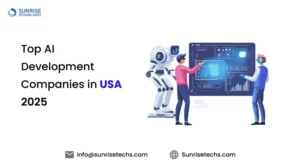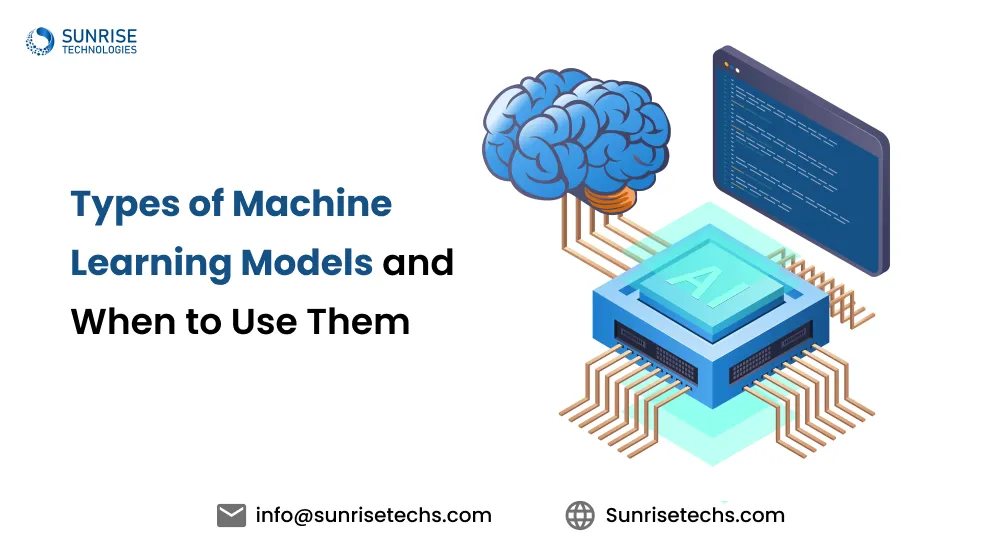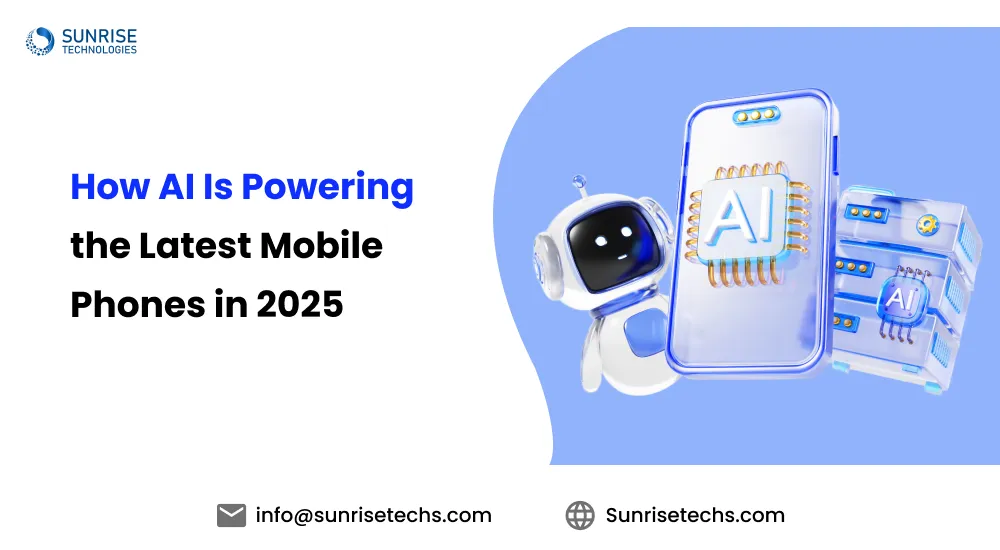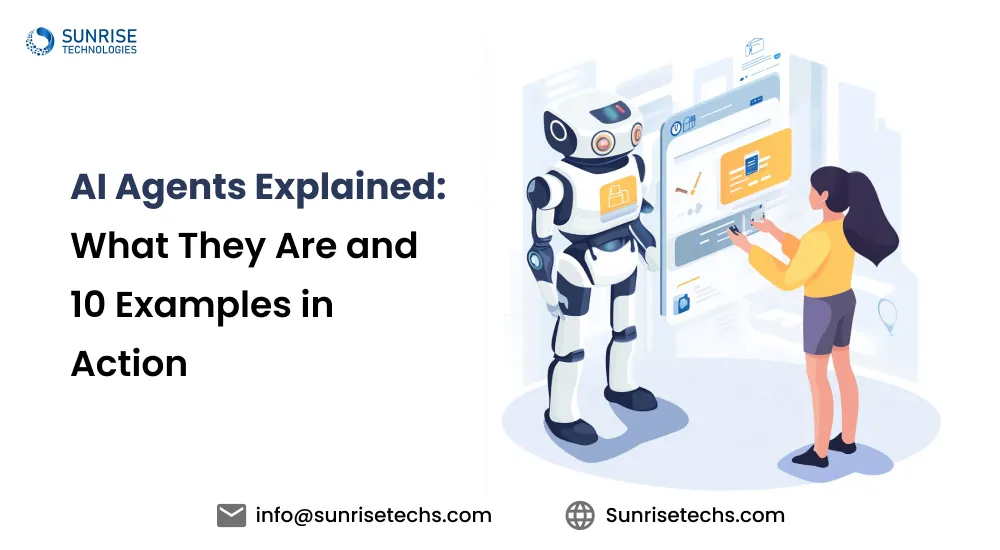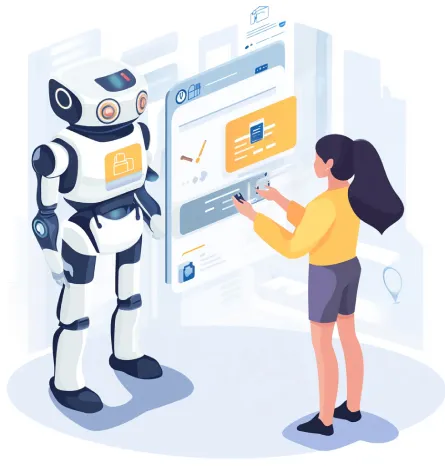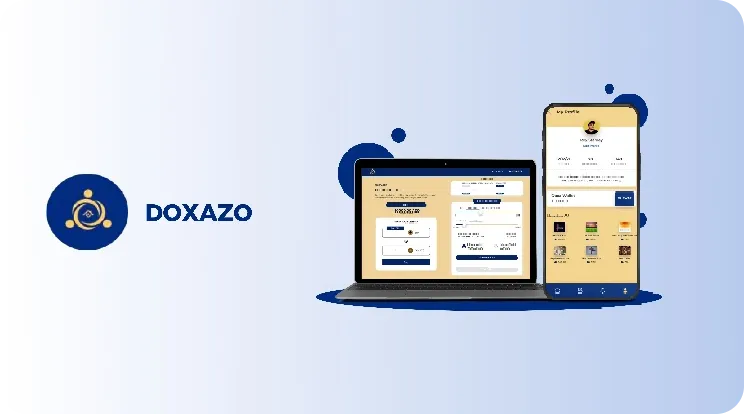AI Agents Explained: What They Are and 10 Examples in Action
May 22, 2025
The impact of AI Agents is already being felt across various sectors, with projections indicating a significant surge in their adoption for AI Automation in the coming years.
- As of mid-2025, studies reveal that businesses implementing Intelligent Agents have reported an average increase of 25% in operational efficiency, highlighting the transformative potential of these technologies.
- By 2025, the global AI automation market is projected to hit $126 billion, with autonomous AI agents driving 40% of enterprise efficiency gains (Gartner, 2023).
- From chatbots handling 85% of customer queries to Generative AI agents drafting legal contracts, intelligent systems are reshaping industries.
Let’s unpack how these AI agents work, their real-world impact, and what the future holds. This blog post will delve into the intricacies of AI Agents Explained: What They Are and 10 Examples in Action, exploring their functionalities, diverse AI use cases and showcasing 10 compelling real-world examples demonstrating their power in action today.
What are AI Agents and How Do They Work?
An AI agent is a software entity that perceives its environment, processes data, and acts to achieve specific goals. AI Agents work by sensing their environment, learning from data, and taking intelligent action based on goals. These agents can operate autonomously, learn from data (thanks to Generative AI agents), and make decisions in real-time.
Core Concepts:
- Perception: Receives data from sensors or external sources.
- Processing: Uses algorithms, often powered by machine learning, to make sense of input.
- Action :Executes decisions based on its objectives.
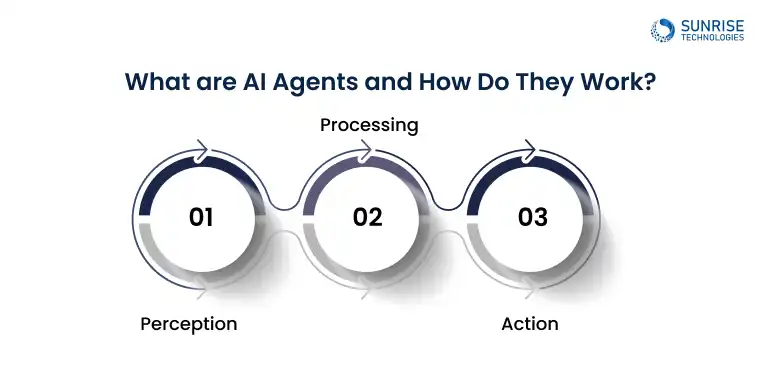
These agents are often embedded into larger AI applications and systems to automate tasks without human intervention.
Types of AI Agents
AI Agents can be categorized based on their complexity and capabilities:
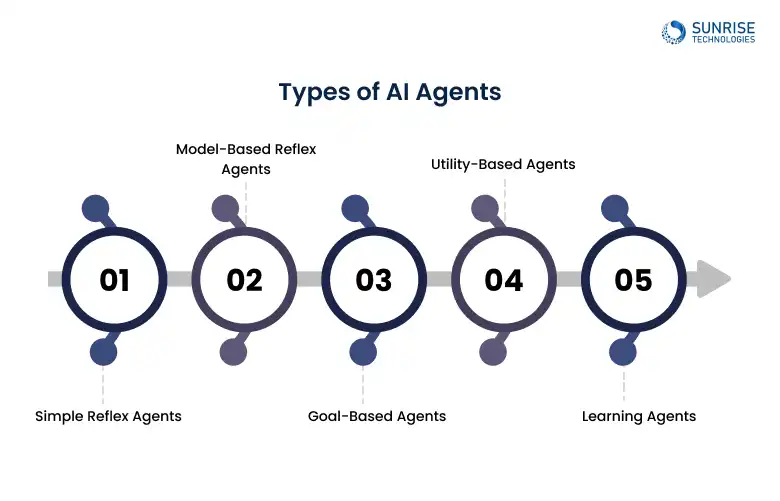
These are the most basic type, reacting directly to perceptions based on pre-defined rules. They don’t have memory of past states.
These agents maintain an internal state, representing the world as they perceive it. This “model” allows them to make decisions based on past experiences and incomplete information.
These agents have a specific goal in mind and take actions to reach that goal. They often involve planning and searching through possible action sequences.
These agents go beyond just having a goal; they aim to maximize their “utility” or happiness. They consider multiple possible actions and choose the one that will lead to the best outcome based on a utility function
These are the most advanced type. They can learn from their experiences, adapt their behavior over time, and improve their performance. They typically include a learning element, a performance element, a critic, and a problem generator.
Chatbot vs AI Agent: Key Differences
Before AI fraud detection can work its magic, it first needs to gather fuel, data. And it doesn’t just look at the blockchain. AI tools extract on-chain data like wallet addresses, token transfers, gas fees, and transaction timestamps.
Simultaneously, they collect off-chain metadata such as:
| Feature | Chatbot | AI Agent |
|---|---|---|
| Intelligence Level | Rule-based or basic NLP | Autonomous, context-aware, self-learning |
| Decision-Making | Predefined responses | Makes decisions based on goals, data, and environment |
| Task Handling | Simple, linear interactions | Complex, multi-step tasks with reasoning |
| Learning Ability | Limited or none | Capable of learning from interactions and outcomes |
| Use Cases | FAQs, customer support, lead gen | Virtual assistants, process automation, smart scheduling |
| Adaptability | Low – struggles with unexpected inputs | High – adapts to new inputs and scenarios dynamically |
| Example | Website support bot | Personal AI assistant, autonomous sales agent |
How AI Agents Work: A Technical Overview
Ever wondered what powers an AI agent behind the scenes? Let’s break down the brains and brawn of these intelligent systems, technically speaking.

Think of this as the AI agent’s senses. It gathers real-time data from its surroundings through a variety of sources, whether it’s a user’s input on a website, sensor readings from IoT devices, or images from a surveillance camera.
Once data is collected, the agent needs to “understand” it. This is where machine learning, deep neural networks, and knowledge representation come in. From recognizing complex patterns to applying logical inference or even probabilistic reasoning, this is where the thinking happens.
With cognition complete, it’s time to act smart. The agent evaluates its goals and environment to plan its next move, often using decision trees, reinforcement learning, or algorithms for pathfinding and optimization.
Now comes the execution. Ao, if it’s sending a command to a robotic arm, triggering a software API, or replying to a customer query, this is where the AI agent brings its decisions to life.
The smartest AI agents never stop learning. Through supervised learning (labeled data), unsupervised learning (finding hidden structures), or reinforcement learning (trial and error with reward feedback), they continuously fine-tune their strategies for better future performance.
Let our experts seamlessly integrate autonomous, goal-driven AI agents into your product to boost performance and innovation.
10 Real-World Examples of AI Agents in Action in 2025
Discover how tech startups and SMBs are leveraging autonomous AI agents to transform everyday operations, accelerate decision-making, and streamline workflows.
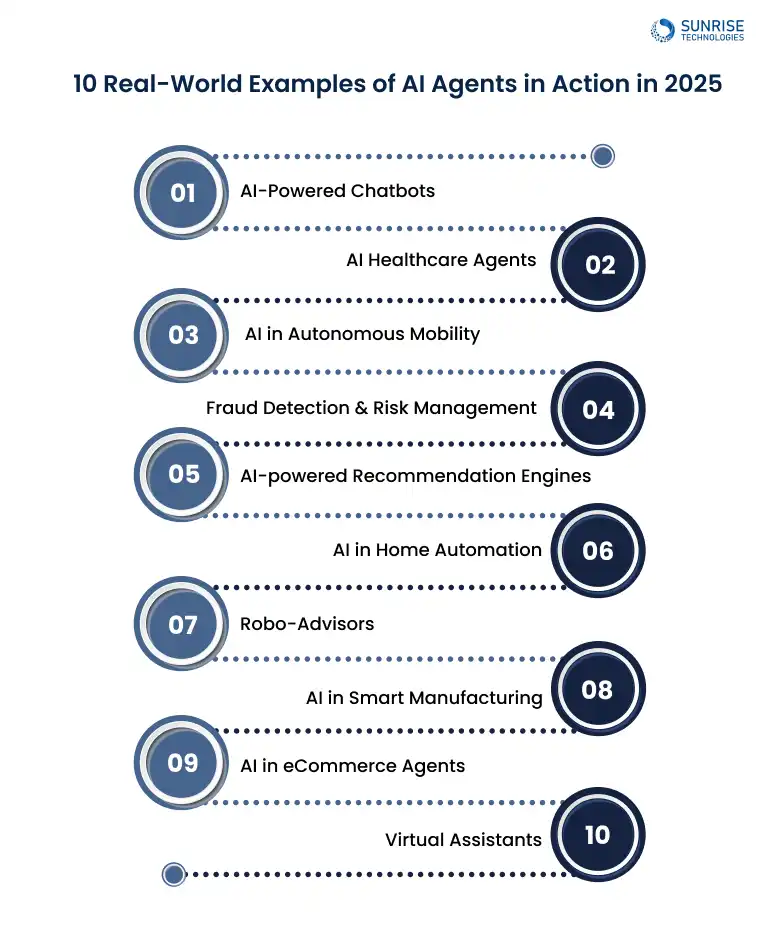
AI-Powered Chatbots have become a ubiquitous form of Customer Service AI Agents, providing instant support, answering frequently asked questions, and guiding users through various processes. Their ability to understand natural language and provide relevant responses has significantly improved customer experience and reduced the workload on human support teams.
Technical overview & Models:
Modern chatbots leverage Natural Language Processing (NLP) techniques, including Natural Language Understanding (NLU) to interpret user intent and Natural Language Generation (NLG) to formulate responses. Transformer-based models, such as BERT, GPT, and their variants, are commonly used for their ability to understand context and generate coherent and human-like text. Knowledge graphs are often integrated to provide chatbots with access to structured information.
Real-World Examples:
- IBM Watson Assistant: Many Fortune 500 companies utilize IBM Watson Assistant to build and deploy sophisticated chatbots across various touchpoints, including customer service, sales, and internal support.
- ServiceNow Virtual Agent: ServiceNow's platform offers AI-powered virtual agents that automate responses to common IT and customer service inquiries, improving efficiency and freeing up human agents for more complex issues.
Healthcare AI Agents are revolutionizing patient care, diagnostics, and drug discovery. These Intelligent Agents can analyze medical images, assist in diagnosis, personalize treatment plans, monitor patient health remotely, and even automate administrative tasks, leading to more efficient and effective healthcare delivery.
Technical overview & Models:
AI in healthcare utilizes various machine learning models, including CNNs for image analysis (e.g., identifying anomalies in X-rays or MRIs), RNNs for analyzing time-series data (e.g., monitoring vital signs), and graph neural networks for understanding complex biological interactions in drug discovery. Natural Language Processing is used for analyzing electronic health records and extracting relevant information.
Real-World Examples:
- PathAI: This company develops AI-powered tools for pathologists, helping them to make more accurate diagnoses of cancer and other diseases by analyzing digital pathology images.
- BioNTech: BioNTech utilizes AI agents, including Generative AI Agents, in their drug discovery and development pipeline, particularly for designing mRNA vaccines and other therapeutics.
Self-driving cars represent a significant leap in AI Automation, promising safer and more efficient transportation. These vehicles utilize a complex array of sensors and sophisticated software to perceive their surroundings, make driving decisions, and navigate without human intervention. The goal is to reduce accidents caused by human error, optimize traffic flow, and provide mobility solutions for a wider range of individuals.
Technical overview & Models:
Autonomous AI vehicles rely on sensor fusion, integrating data from cameras, lidar, radar, and ultrasonic sensors to create a comprehensive understanding of their environment. This data is processed by deep learning models, particularly Convolutional Neural Networks (CNNs) for image and object recognition, and Recurrent Neural Networks (RNNs) or Transformers for understanding temporal sequences and predicting the behavior of other agents. Reinforcement learning is also employed to train driving policies.
Real-World Examples:
- Tesla Autopilot and Full Self-Driving (FSD): While still under development and requiring driver supervision, Tesla's systems utilize a vision-centric approach with neural networks to enable features like lane keeping, automatic lane changes, parking, and navigation on city streets.
- Waymo (Alphabet Inc.): Waymo operates a fully autonomous ride-hailing service in limited geofenced areas, utilizing a suite of custom-built sensors and AI software to provide driverless transportation to the public.
Fraud Detection AI Agents play a crucial role in protecting businesses and consumers from financial losses. These systems analyze vast amounts of transaction data in real-time to identify suspicious patterns and anomalies that may indicate fraudulent activity, significantly enhancing security and reducing financial risks.
Technical overview & Models:
These agents often employ machine learning algorithms like anomaly detection techniques (e.g., Isolation Forest, One-Class SVM), classification models (e.g., Logistic Regression, Random Forests, Gradient Boosting), and deep learning models (e.g., Autoencoders, Recurrent Neural Networks for sequential transaction analysis) to identify fraudulent behavior. Graph-based methods are also used to analyze relationships between entities and detect fraudulent networks.
Real-World Examples:
- J.P. Morgan Chase: Major financial institutions like J.P. Morgan Chase utilize sophisticated AI-powered fraud detection systems to monitor millions of daily transactions and identify potentially fraudulent activities in real-time.
- PayPal: PayPal employs advanced AI algorithms to analyze user behavior and transaction patterns to detect and prevent fraudulent transactions on its platform, protecting both buyers and sellers.
AI-Based Recommendation Engines are Intelligent Agents that analyze user behavior, preferences, and item characteristics to suggest relevant products, content, or services. These engines are crucial for enhancing user engagement, driving sales, and improving user satisfaction across various online platforms.
Technical overview & Models:
These engines utilize collaborative filtering (recommending items liked by similar users), content-based filtering (recommending items similar to those the user has liked in the past), and hybrid approaches that combine both. Machine learning algorithms like matrix factorization, deep learning models (e.g., neural collaborative filtering), and graph-based methods are commonly employed.
Real-World Examples:
- Amazon Product Recommendations: Amazon's recommendation engine analyzes purchase history, browsing behavior, and product ratings to suggest relevant items to shoppers.
- Netflix Content Recommendations: Netflix uses sophisticated AI algorithms to recommend movies and TV shows based on viewing history, ratings, and the behavior of users with similar tastes.
Smart Home Devices integrate AI Agents to create more convenient, efficient, and secure living environments. These devices can learn user preferences, automate tasks like adjusting lighting and temperature, and respond to voice commands, making homes more intelligent and responsive to their occupants’ needs.
Technical overview & Models:
Smart home Intelligent Agents often utilize Natural Language Understanding (NLU) for voice control, machine learning for learning user routines and preferences, and sensor data processing to react to environmental changes. Edge computing allows some processing to occur locally on the device, improving responsiveness and privacy.
Real-World Examples:
- Amazon Echo (Alexa): Amazon's Echo devices use the Alexa voice assistant, an AI Agent, to respond to voice commands, play music, set reminders, control smart home devices, and provide information.
- Google Nest Hub: Google's Nest Hub integrates the Google Assistant, another prominent AI Agent, offering similar functionalities to Alexa with a visual interface and integration with Google's ecosystem.
Financial Robot-Advisors are AI Agents that provide automated investment advice and portfolio management services. They analyze user financial goals, risk tolerance, and time horizon to create and manage personalized investment portfolios, making financial planning more accessible and affordable.
Technical overview & Models:
These agents utilize algorithms based on Modern Portfolio Theory (MPT) and other financial models. They employ machine learning for tasks like market forecasting, risk assessment, and portfolio optimization. Natural Language Processing can be used to interact with users and explain investment strategies.
Real-World Examples:
- Betterment: Betterment is a leading robo-advisor platform that uses AI algorithms to build and manage diversified investment portfolios for its users based on their financial goals.
- Schwab Intelligent Portfolios: Charles Schwab's robo-advisor service provides automated portfolio management with no advisory fees, utilizing AI to construct and rebalance investments.
Robotics in Manufacturing increasingly incorporates AI Agents to create more flexible, efficient, and adaptive production lines. AI-powered robots can perform complex tasks, collaborate with human workers, learn new skills, and even identify and resolve issues autonomously, leading to increased productivity and quality.
Technical overview & Models:
AI in manufacturing robots involves computer vision for object recognition and quality control, reinforcement learning for optimizing robot movements and task execution, and path planning algorithms for navigation in dynamic environments. Collaborative robots (“cobots”) utilize AI for safe and intuitive interaction with human workers.
Real-World Examples:
- ABB and Fanuc: These leading robotics companies are developing and deploying AI-powered industrial robots capable of tasks like welding, painting, assembly, and material handling with greater precision and adaptability.
- Amazon Warehousing Robots: Amazon utilizes AI-powered robots in its warehouses for tasks like picking, packing, and sorting items, improving efficiency and speed in order fulfillment.
ECommerce AI Agents are transforming the online shopping experience by providing personalized recommendations, assisting with product search, offering customer support, and even dynamically adjusting prices. These Intelligent Agents aim to enhance customer engagement, increase sales, and optimize business operations for online retailers.
Technical overview & Models:
These agents utilize recommendation engines (as described earlier), Natural Language Processing (NLP) for chatbots and product search, and machine learning for dynamic pricing and inventory management. Computer vision can also be used for visual search and product recognition.
Real-World Examples:
- Shopify Compass: Shopify offers AI-powered tools within its platform to help merchants with tasks like product recommendations, marketing automation, and inventory forecasting.
- ASOS Fit Assistant: ASOS uses AI-powered tools to help customers find the right size and fit when shopping online, reducing returns and improving customer satisfaction.
Virtual Assistants like Siri, Google Assistant, and Cortana are AI Agents designed to assist users with a wide range of tasks through natural language interaction. They can answer questions, set reminders, send messages, make calls, and perform various other functions, acting as intelligent personal assistants.
Technical overview & Models:
These agents rely heavily on Natural Language Processing (NLP) for understanding and responding to user queries. They utilize speech recognition to convert spoken language to text, Natural Language Understanding (NLU) to interpret the meaning, and Natural Language Generation (NLG) to produce human-like responses. Knowledge graphs provide them with vast amounts of information.
Real-World Examples:
- Apple Siri: Integrated into Apple's devices, Siri uses natural language to help users with tasks like setting alarms, sending messages, and getting information.
- Microsoft Cortana: While its focus has shifted, Cortana still exists as a personal productivity assistant within Windows and other Microsoft products, offering features like task management and information retrieval.
Benefits of Using AI Agents in Business Operations
So, Why AI Agents Matter for Startups and Small Businesses? AI agents are revolutionizing business operations, from automating tedious tasks to providing data-driven insights. They bring smarter decision-making, improved efficiency, and enhanced customer experiences across industries.
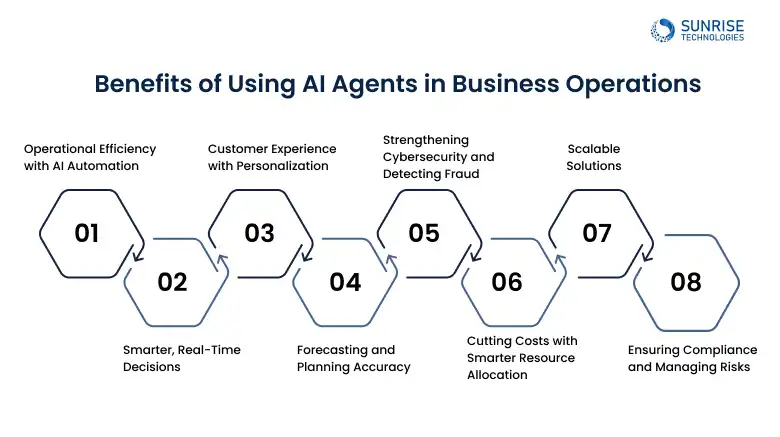
AI agents handle repetitive tasks seamlessly, freeing up time for your team to focus on innovation. Using RPA and ML models, they ensure precision in processes like ERP and CRM.
AI agents analyze data in real-time, helping businesses make informed decisions quickly. By leveraging predictive analytics and Time-Series Forecasting, they provide insights that drive strategy.
AI agents deliver tailored responses around the clock, elevating customer engagement. With NLP and models like BERT and GPT, they understand user intent and adapt to each interaction.
AI agents refine demand forecasting by recognizing patterns in data, making predictions more reliable. LSTM networks and regression models boost the accuracy of business planning and resource allocation.
AI agents proactively detect fraud and security threats by monitoring behavior and identifying anomalies. Using tools like Autoencoders and Graph Neural Networks, they safeguard your business 24/7.
By automating processes, AI agents reduce waste and downtime, lowering operational costs. Through optimization algorithms and digital twins, they enhance resource efficiency across departments.
As your business expands, AI agents grow with you, adjusting to new demands. Using cloud-based AI platforms, they scale seamlessly and continue learning without major system changes.
AI agents simplify compliance by monitoring regulations and flagging potential issues. With ontology-based models and text mining, they streamline legal and risk management tasks.
Use cases and Applications of autonomous AI agents in different industries
AI agents are becoming indispensable across industries, offering solutions that streamline processes, enhance decision-making, and provide significant operational efficiency. Their application spans sectors like healthcare, finance, manufacturing, and more, revolutionizing the way businesses operate.
Let’s explore the Applications AI Agent Development:
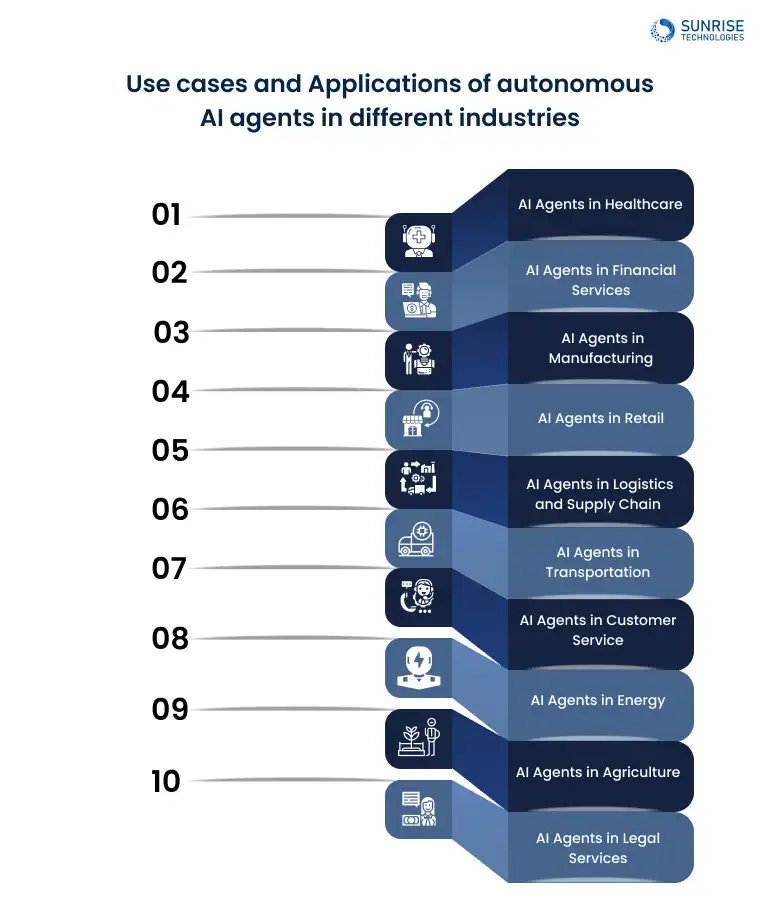
In healthcare, AI agents play a critical role in automating diagnosis, improving patient care, and managing large sets of medical data. By analyzing patient records and medical images, AI agents help doctors make more accurate decisions.
Using machine learning (ML) and computer vision technologies, these agents can identify patterns in medical images, predict diseases, and suggest personalized treatment plans, enhancing the quality and speed of healthcare delivery.
The financial services industry has greatly benefited from custom AI agents, which help in fraud detection, automated trading, and risk management. Role of AI agents in automating financial trading strategies can process vast amounts of data in real time, allowing them to detect unusual patterns that may indicate fraudulent activity.
By leveraging predictive analytics and deep learning models, AI agents in finance automate tasks such as credit scoring, portfolio optimization, and fraud detection, which significantly reduces human error and enhances decision-making accuracy.
Implementing AI agents for predictive maintenance in manufacturing, makes to automate complex processes, reduce downtime, and enhance product quality. From predictive maintenance to supply chain optimization, AI-powered systems are streamlining operations at every step of the production line.
Using sensor data and computer vision techniques, AI agents monitor machinery for wear and tear, predict potential failures, and improve efficiency in assembly lines, ultimately leading to cost savings and enhanced operational efficiency.
Developing AI agents for personalized shopping experiences,as they transforming the customer experience by offering personalized recommendations, assisting with virtual shopping, and managing inventory. These agents analyze customer preferences, purchase history, and browsing behavior to suggest tailored products.
Utilizing natural language processing (NLP) and machine learning algorithms, AI agents engage customers through chatbots, provide product recommendations in real-time, and automate stock management to ensure optimal inventory levels.
AI agents in logistics and supply chain management help companies optimize routes, monitor inventories, and track shipments. These agents use data from IoT devices and real-time analytics to manage inventory efficiently and ensure timely deliveries.
With route optimization algorithms and machine learning models, AI agents improve delivery schedules, reduce fuel consumption, and enhance warehouse management, ensuring smoother operations and improved customer satisfaction.
In transportation, AI agents are powering autonomous vehicles and optimizing traffic management systems. These agents process vast amounts of real-time data from sensors, cameras, and radar to make driving decisions autonomously.
By using computer vision and deep learning algorithms, AI agents can navigate vehicles, detect obstacles, and predict traffic patterns, contributing to safer roads and more efficient transportation systems.
AI agent development for customer support have revolutionized how businesses interact with customers. These agents handle routine inquiries, provide 24/7 support, and escalate complex issues to human agents when necessary.
By utilizing NLP and dialogue management systems, AI agents can comprehend customer queries, offer solutions in real-time, and personalize interactions, all while reducing response times and improving customer satisfaction.
The energy sector is increasingly adopting AI agents to manage power grids, optimize energy consumption, and ensure the efficient distribution of resources. These agents monitor energy usage patterns and adjust distribution based on demand.
With the help of predictive analytics and IoT sensors, AI agents optimize energy generation from renewable sources, forecast energy consumption, and balance load distribution across grids, ensuring sustainability and cost savings.
In agriculture, AI agents are used to automate tasks like irrigation, crop monitoring, and pest control. These agents utilize sensors, drones, and machine learning algorithms to gather real-time data from farms and make decisions to improve crop yield and reduce resource wastage.
By analyzing weather patterns, soil conditions, and plant health data, AI agents help farmers optimize planting schedules, minimize pesticide use, and predict the best harvest times, contributing to more sustainable agricultural practices.
In legal services, AI agents assist in automating document review, legal research, and contract analysis. These agents can quickly scan and analyze vast quantities of legal documents, making it easier for lawyers to find relevant case precedents and terms.
By utilizing NLP and machine learning models, AI agents extract key insights from legal texts, reducing the time spent on manual research and ensuring better accuracy in compliance checks and legal advice.
Our experts will work with you to integrate automation that drives efficiency, innovation, and results.
Future Trends in AI Agents Across Business and Technology
As businesses continue to evolve digitally, AI agents are moving from being task executors to becoming autonomous decision-makers. From smart predictions to real-time personalization, here’s how the future of AI agents is shaping up across industries.
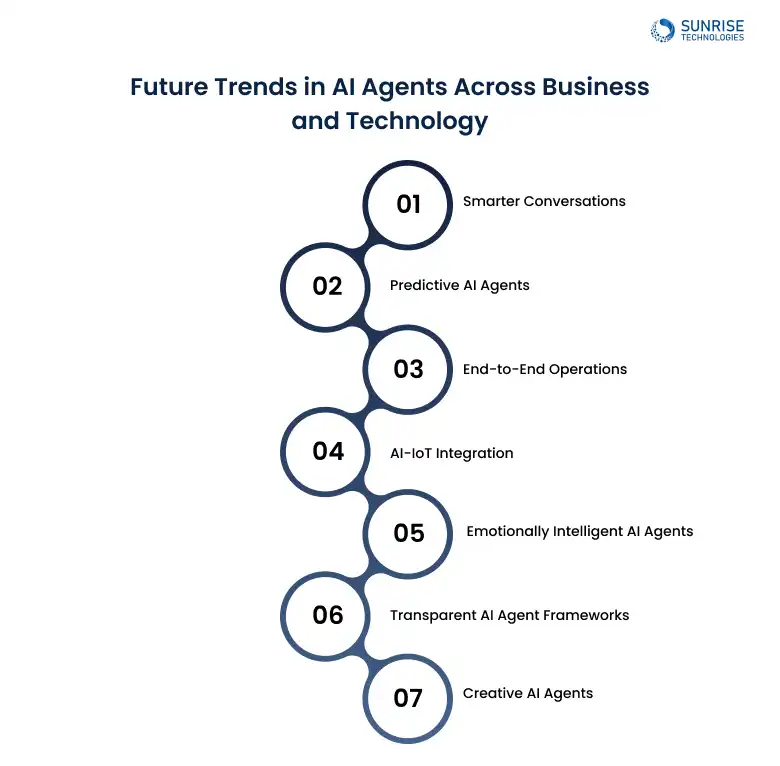
AI agents are getting better at human-like chats thanks to NLP models like GPT-4 and BERT. Soon, they’ll not just understand words, but emotions, tone, and even sarcasm, making them perfect for customer service and virtual assistant roles.
The future lies in AI agents that forecast trends and customer behavior using time-series forecasting, classification models, and real-time analytics, helping industries like finance and eCommerce make sharper, data-driven decisions.
AI agents will evolve into fully autonomous systems, capable of making decisions, executing workflows, and even learning on the fly. Think of them as digital coworkers that never sleep, ideal for supply chains, logistics, and IT automation.
Merging AI agents with IoT sensors will drive intelligent automation in smart homes, factories, and cities. These agents will monitor, analyze, and act on data from connected devices to improve energy usage, safety, and operations.
Future AI agents will recognize not just what users say, but how they feel. By combining emotion detection APIs and sentiment analysis, these agents will personalize interactions in fields like healthcare and mental wellness apps.
Expect more focus on building ethical AI agents, ones that are bias-aware, explainable, and fair. With explainable AI (XAI) models and strict compliance protocols, trust and transparency will be baked into their decision-making.
From AI-generated music to fashion design, creative industries are embracing generative AI agents powered by GANs and transformers. These agents won’t replace artists, but will collaborate to unlock entirely new forms of expression.
Choose Sunrise Technologies for AI Agent Automation
As a top AI agent development company in the USA and Australia, Sunrise Technologies brings unmatched expertise in building intelligent, scalable automation solutions tailored for enterprise needs.
- 1. Expertise in custom AI Agent Development for industries like healthcare, retail, finance, and logistics
- 2. Proven Track Record delivering high-performance AI applications powered by NLP, RPA, ML, and more
- 3. Custom AI Automation Solutions aligned with business goals and technical infrastructure
- 4. Global Delivery Model with dedicated teams across the USA and Australia
- 5. Cutting-Edge Tech Stack using GPT-4, BERT, TensorFlow, PyTorch, and scalable cloud platforms
- 6. Agile Development Approach for faster go-to-market and continuous improvement
Final Thoughts
In a world driven by digital velocity and automation-first strategies, AI agents in business operations are no longer optional, they’re essential. From predictive analytics and personalized experiences to real-time decision-making, AI agents are transforming how enterprises function. As businesses scale, the integration of autonomous AI systems is becoming the foundation of operational efficiency, customer satisfaction, and competitive edge. Partnering with a top AI app development company ensures these solutions are tailored, compliant, and future-ready.
At Sunrise Technologies, we specialize in building intelligent AI agents that not only automate tasks but also evolve with your business. As the best AI agent development services provider in Australia and the USA, our mission is to empower companies with scalable, secure, and smart automation tools. Whether you need custom AI workflows, chatbot integration, or intelligent recommendation engines, Sunrise Technologies delivers innovation with precision.
Let our AI automation experts guide you through the process of integrating cutting-edge AI technology into your solutions, we tailor AI agents to fit your business needs.
The core AI agent architecture includes perception modules, machine learning models, a decision-making engine, and output interfaces. These elements work together to enable autonomous actions and intelligent responses.
The cost of AI agent development varies based on complexity, industry, and required features, but typically starts from $10,000 to $100,000+. Partnering with a top AI agent development company ensures optimized ROI and scalability.
AI agents are being used in various industries, from automating customer support through chatbots to optimizing supply chain management by predicting demand and inventory needs. In retail, AI agents help personalize recommendations, while in finance, they assist in fraud detection and risk management.
AI agents enhance customer service by providing instant, 24/7 support through chatbots and virtual assistants, ensuring quicker response times. They also analyze customer interactions, allowing businesses to offer personalized experiences and resolve issues efficiently.
Generative AI agents use large language models (LLMs), GANs, and diffusion models to create text, images, or simulations. These agents analyze patterns in training data to generate novel, contextually relevant content, and team up with top AI agent development companies like Sunrise Technologies.
Sam is a chartered professional engineer with over 15 years of extensive experience in the software technology space. Over the years, Sam has held the position of Chief Technology Consultant for tech companies both in Australia and abroad before establishing his own software consulting firm in Sydney, Australia. In his current role, he manages a large team of developers and engineers across Australia and internationally, dedicated to delivering the best in software technology.


